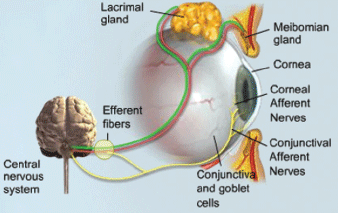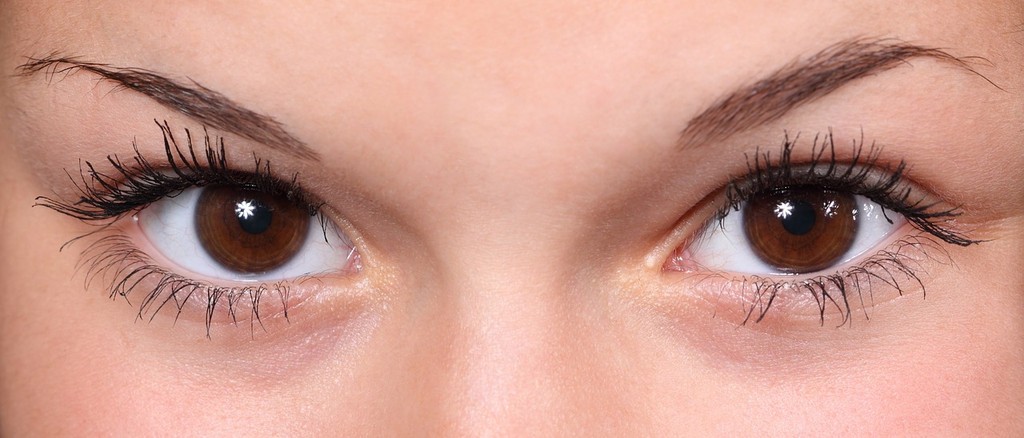Dry eye is a painful and very irritating condition. The eyes sting, burn, hurt, and are just maddening to deal with. So far the treatments available have only been able to offer temporary relief, and it’s usually only a short time before the uncomfortable sensations return. In other words, dry eye treatments thus far have only been able to manage the condition, and not cure it, so sufferers continue to struggle with chronic dry eye. In this article, we’ll find out if taking omega-3 for dry eyes is a good idea.
Dry eyes can be such an issue that a 2014 study found that sufferers had lower scores on mental health tests, as well as lower quality of life scores (1-2). However, there is a lot of exciting research on effective supplements for dry eyes.
In particular, the most successful research has focused on omega-3 fatty acids. We’ll take a look in detail at this research to see whether omega-3 fish oil for dry eyes is really effective. Also at the end, we’ll cover my 3 step action plan that you can take to significantly improve dry eye symptoms and discomfort completely naturally.
First though, to fully understand how and why omega-3 and the natural action plan can help, we need to look at an overview of what dry eye syndrome or dry eye disease actually is, and it’s causes.

Table of Contents
What is Dry Eye Syndrome?
Dry eye is literally eye dryness which is caused by either decreased tear production or increased tear evaporation. It’s the most common eye complaint and affects 5-6% of the population at any one time, although this can increase to 9.8% in post-menopausal women (3) and 34% in the elderly (4).
Our eyes are covered by a very thin layer of moisture which is crucial for proper eye lubrication and function. The layer is known as the ‘tear film’ and consists of three different layers made of mucus, water, and oil.
The layer closest to the eye, which is directly over the cornea is the mucus layer. It provides lubrication as well as protection to the cornea. If there is not enough mucus it can lead to dry spots on the eye surface.
The middle watery layer is produced by the lacrimal glands. These glands produce the tears which are made of a very dilute saltwater solution. Tears are the main component of a thin liquid layer that coats the eye. Not only do they keep the eye moist, but they also help protect it and flush out any debris. These tears, unlike the ones when we cry, actually run throughout the watery layer constantly.
The tears nourish the cornea as it doesn’t have a blood supply of it’s own, and contain glucose, as well as Vitamin C, other antioxidants such as Glutathione and antimicrobials to protect the cornea from oxidation from the air pollution, bacteria and other foreign particles that would otherwise damage it.

The outer lipid layer is produced by the Meibomian (tarsal) glands. They are located around the rim of the eyelids, these glands produce an oily lipid substance called meibum. This substance forms the outer lipid layer over the liquid layer containing the tears and keeps the tears from evaporating too quickly. There are approximately 30 – 40 glands on the upper eyelids and 20 – 30 glands on the lower eyelids (5).
When either of these two gland types are not working properly, it can lead to dry eyes. If the lacrimal glands aren’t functioning properly, not enough tears are being produced to keep the eyes moist. If the meibomian glands are affected, not enough meibom is being produced to protect the watery layer, and that causes the tears to evaporate at a quicker rate leading to dryness (6).
Dry eyes are often accompanied by the red and puffy hallmark of inflammation, but inflammation is not only a symptom of dry eyes. Recent studies have shown that inflammation is actually a cause as well. Inflammation targeted around the lacrimal glands will damage the glands and decrease tear production (8).
When the Meibomian glands become inflamed, this also leads to some uncomfortable problems. Not only can dry eyes result from the inflammation, but it may also cause styes and infections within the glands and eye, Blepharitis and Meibomian Gland Dysfunction (7). Blepharitis and MGD symptoms are often indistinguishable from Dry Eye.
Inflammation of the Meibomian glands also alters the composition of the meibom they produce. It may become more sticky or granular and change color. Also the fatty acid composition of the meibom changes with the level of saturated fats in the lipid layer increasing whilst the level of unsaturated fats decreases (8). Because saturated fats are solid at body temperature and unsaturated fats are liquid, the increase in saturated fats causes the meibom to become more solid. This is one of the reasons why hot compresses can often bring relief in dry eye, because they melt the more solid meibom, making it more fluid and natural.
As a result, the meibom changes in consistency can clog the glands. This increases the risk of infection and hinders the gland from releasing meibom. Over time, the glands may become permanently scarred and experience long-term malfunction.
Inflammation of the Lacrimal and Meibomian glands causes a vicious cycle, where inflammation leads to damage on the eye surface, which in turn leads to more inflammation and even less tears being produced, or tears continuing to evaporate too quickly (8). This can lead to damage to the cornea (the thin region at the outermost point of the lens) and the conjunctiva (the lubricating cell layer that lines the eyeball and inner surfaces of the lids) (6).
Symptoms of Dry Eye – Chronic Dry Eye Disease Symptoms
Typical symptoms are dryness, burning, scratchy or stingy and the eye can increase as the day goes on. There may also be redness and pressure behind the eye. There is often sensitivity to light and usually both eyes will suffer.
There is also often a stringy discharge, and paradoxically the irritation may also cause the eyes to tear, although these usually don’t ease symptoms as they are the watery type produced when we normally ‘cry’, rather than the lubricating tears from the Lacrimal glands.
Blinking helps to coat the eyes, so any activities such as driving, reading and watching TV, or working on a computer can make symptoms worse because we spend long periods of time without blinking.
Causes of Dry Eye – Where Does Dry Eye Come From?
Recent studies have shown the incidence of dry eye is on the rise in the USA, and throughout the world (6), with some of the causes being the increasing use of computers, wearing contacts, and corrective eye surgery or LASIK (9, 10, 11, 12).
However, there are further dry eye causes closely linked to long term health problems, they are:
AutoImmune Responses
An autoimmune response is thought to be a cause of Dry Eye. Autoimmune responses increase with ageing, which is one of the reasons why the disease is more common in the elderly. Autoimmune responses are the body’s way of dealing with what it believes to be threats i.e inflammation, and it responds by activating the immune system causing more inflammation. In other words the body actually starts attacking itself in another vicious cycle. Diseases like type 1a diabetes, arthritis, lupus, and Sjögren’s syndrome are some of the autoimmune conditions that cause inflammation, and if you suffer from one of these you might also be at increased risk for Dry Eye.
Hormones – What Hormones Cause Dry Eye?
Studies have found both androgen and estrogen receptors on the cornea and on the meibomian glands. This means that sex hormones can affect the eyes. This is the reason why menopausal women and post menopausal women are at a greater risk, because as they go through changes their hormonal balance is upset. Hormonal imbalances are a key source of inflammation, and this inflammation “could be a key reason why women suffer 75% of all auto-immune disease” (13).
Vitamin and Omega-3 Deficiencies – Which Vitamin Deficiencies Cause Dry Eye?
Researchers have found an association between low vitamin D levels and dry eye (14). The study conducted on women found up to 74% of women who were vitamin D deficient also had dry eyes. They suggested that normal Vitamin D levels are able to prevent dry eyes by stimulating the release of cathelicidin, an antimicrobial protein that can be produced by cells in the eyes and heal eye wounds.
A deficiency of omega-3 fatty acids also raises the risks of experiencing dry eye syndrome. A 2005 study published in the American Society for Clinical Nutrition found that women with a high omega-3 intake had lower rates of dry eye syndrome. On the reverse, those with a low intake of omega-3 had higher rates of the syndrome (15). The reason for this is again due to inflammation.
A deficiency of omega-3 fatty acids causes an increase of the omega 6 to omega 3 ratio. This is a key source of inflammation in the body, with an abundance of omega-6 fats being inflammatory and omega-3 fats being anti-inflammatory. In the USA, the omega 6:3 ratio averages between 15:1 and 18:1, whereas in the Mediterranean area of Europe, known for its health and long life expectancy, the ratio is around 4:1 (8).
The main causes of dry eyes are centered around inflammation in the body. So, when looking for a dry eyes solution we need to focus on reducing inflammation. This needs to be done on a holistic basis, i.e changing our diets and lifestyles so they produce less stress and inflammation, as well as looking for specific remedies for dry eyes that can work directly on the inflammation in the eye area.
Dry Eye Treatment – What To Do For Dry Eyes
The current focus on treatments is the management of the condition rather than a cure through over-the-counter and prescription eye drops. In the USA alone, sales of eye drops have reached millions of dollars a year, however whilst these ‘artificial tears’ can help relieve the symptoms and provide temporary relief, they have little to no long-lasting effects (16, 17).
In fact, their long term use can actually cause more damage. For example, many nonprescription decongestant eyedrops contain chemicals that can further irritate the eye, like Tetrahydrozoline.
In one study, long-term use of nonprescription eyedrops containing Tetrahydrozoline has been shown to cause a significant change in the cornea of 27% of users (18). Studies have also shown that nonprescription eyedrops containing vasoconstrictors as Tetrahydrozoline may cause conjunctivitis (inflammation of the conjunctiva) (19).
Prescription eye drops are little better, brands such as Restasis have side effects including pain, stinging, redness, watery eyes, discharges, etc. One study showed that 54.2% of the people using these treatments experienced eye discomfort and pain from them (20).
Other treatments such as corticosteroids which act as anti-inflammatories can also help symptoms, but again only on a short-term basis, as corticosteroids should not be taken long term.
The real problem with all of these treatments is that they focus on the symptoms and not the cause. We can only be successful in dealing with dry eye in the long term if we focus on the real cause – inflammation (21).
Is There Another Cure For Dry Eyes? – How to Fix Dry Eyes Naturally
We can reduce inflammation naturally, we just have to consider our diet and lifestyles. To make this as simple as possible we can split these changes into 3 action points.
Omega-3 for dry eyes action point 1: Reduce the Omega 6:3 ratio
The most powerful natural remedy for dry eye is balancing the omega 6:3 ratio. The great thing about this is that it’s a completely natural home remedy for dry eye. Balancing the ratio not only helps us reduce inflammation that directly affects our eyes, but it will also help other autoimmune problems as well as helping to balance our hormones and improving our general health and well-being.
The first way to balance the ratio is by reducing the amount of omega-6 in our diets. We do that by reducing processed foods and foods that contain refined sugars. It also means cutting out vegetable oils when cooking, and using healthy fats like coconut oil instead. If you can also go for grass-fed meats and wild fish, as grain-fed meats and farmed fish have much higher omega–6 contents.
Supplements for Dry Eye
The second way to balance the ratio is to increase our omega-3 intake, the easiest way to do this is with a high-quality omega-3 supplement.
There have been several comprehensive studies conducted on omega-3 supplementation and dry eye. The results have been very exciting.
The first study supplemented with 6 grams of flaxseed per day for a year. Flaxseed is rich in the omega-3 fatty acid ALA (which would be equal to around 600mg of EPA per day). The results showed that as the omega 6:3 ratio was reduced (i.e more omega-3 and less omega-6), there was less ocular inflammation (less inflammation on the surface of the eye), and an increase in tear break up time (so tears did not evaporate so quickly), and a significant increase in the health of the meibomian glands so that they produced a more fluid meibum. This lead to a significant improvement in all dry eye symptoms (8). There was also a reduced risk of the glands clogging or suffering permanent damage from inflammation.
Another study supplementing with 712mg of omega-3 (427 EPA 285 DHA) per day, found that it led to a significant reduction in inflammation of the conjunctiva, which is the mucous membrane of the ‘tear film’ (21).
A 2013 study using just 600mg (360mg EPA and 240mg DHA) of omega-3 per day found a significant reduction in tear evaporation and significant improvement in tear production and overall dry eye symptoms, including burning, stinging, dryness, and the sensation of a foreign object in the eye, etc (25).
A 2011 study with a daily dose of fish oil (450mg of EPA, 300mg of DHA), and 1000mg of flaxseed oil (equivalent to around 100mg of EPA) found that by the end of the 90 day study period 70% of the participants were symptom free! (26)
And finally, another 2013 study found that with a 1000mg daily dose of omega-3 (650 EPA and 350 DHA) there was a 400% improvement in dry eye symptom scores after just 3 months (27).
The studies really show the power of fish oil supplementation for improving dry eye symptoms. Fish oil will not just improve symptoms but is also valuable in dry eye prevention.
Perhaps the most exciting part is that so far all the studies on omega-3 supplementation and dry eye have been at quite low doses, so there is great potential for even better results at higher doses, as they will be able to decrease the omega 6:3 ratio even more. We recommend starting with a daily 3 capsule serving of our Ultra Pure Omega-3.
Omega-3 for dry eyes action point 2: Get plenty of Vitamin D and Vitamin C
A 2015 study showed a strong association between low vitamin D levels (< 20 ng/mL) and dry eye (14). If you live in an area where it’s difficult to get out in the sun, or you want to limit your time in the sun due to skin cancer fears then use a good Vitamin D supplement, ideally at least 5000 IU per day.
Also make sure you are getting a lot of Vitamin C as it is required to nourish the cornea. Ideally this can be done through your diet. If you are reducing processed foods in your diet as suggested above, you should be replacing them with fresh fruit and vegetables and they will provide enough Vitamin C.
Omega-3 for dry eyes action point 3: Lifestyle changes
Limit your time in front of the TV or computer, or make sure to take regular breaks and remember to blink! Try to avoid pollutants and other irritants, smoke for example aggravates eyes, so if you smoke give up, or at least cut down as much as possible. Rubbing your eyes also affects the tear film and can add irritants to the eyes. If you wear make up try hypoallergenic brands.
Also try to get enough sleep, drink plenty of water and try to reduce stress as much as possible. Lastly, make sure you are exercising! Exercise will improve blood flow to the eyes, which will always reduce inflammation and improve your overall health.
Conclusion
Eye drops can temporarily relieve dry eye syndrome, but the symptoms always return. Reducing your omega 6:3 ratio and making other sensible lifestyle adjustments, however, will work from the inside to stop the inflammation that leads to dry eye syndrome, and improve the overall health of your eyes and body. Following the 3 action points can lead to sustained relief from dry eyes and prevent reoccurring dryness, pain and irritation. It’s not an immediate fix, but it can provide long-term relief.
Make sure you choose the best omega-3 fish oil supplement for dry eye relief. At Intelligent Labs, we have produced the strongest purest omega-3 fish oil for dry eyes, so give us a try!
References
(1) Dry eye disease is associated with deterioration of mental health in male Japanese university staff, Tounaka K, Yuki K, Kouyama K, et al.Tohoku J Exp Med. 2014;233(3):215-20.
(2) Impact of dry eye syndrome on vision-related quality of life in a non-clinic-based general population, Le Q, Zhou X, Ge L, Wu L, Hong J, Xu J BMC Ophthalmol. 2012 Jul 16;12:22.
(3) Prevalence of dry eye syndrome among US women, Schaumberg DA, Sullivan DA, Buring JE, Dana MR (August 2003), American Journal of Ophthalmology 136 (2): 318–26.
(4) Association between symptoms and signs of dry eye among an elderly Chinese population in Taiwan: the Shihpai Eye Study, Lin PY, Cheng CY, Hsu WM, et al. (May 2005), Investigative Ophthalmology & Visual Science 46 (5): 1593–8.
(5) Bron AJ, Tiffany JM. The contribution of meibomian disease to dry eye. Ocul Surf. 2004;2(2):149‐165.
(6) Horwath-Winter J, Schmut O, Haller Schober EM, Gruber A, Rieger G. Iodide iontophoresis as a treatment for dry eye syndrome. Br J Ophthalmol. 2005 Jan;89(1):40-4.
(7) Udell IJ, Nally L, Abelson M. An update on blepharitis treatment. Rev Ophthalmol. 2000:164–166.
(8) Macsai, M. (2008). The Role of Omega-3 Dietary Supplementation in Blepharitis and Meibomian Gland Dysfunction (An AOS Thesis). Transactions of the American Ophthalmological Society, 106, 336–356-336–356.
(9) Pflugfelder SC, Solomon A, Stern ME. The diagnosis and management of dry eye: a twenty-five-year review. Cornea. 2000;19:644–649.
(10) Etiology, prevalence, and treatment of dry eye disease, Gayton JL. Clin Ophthalmol. 2009;3:405-12.
(11) Yazici A, Sari ES, Sahin G, et al. Change in tear film characteristics in visual display terminal users. Eur J Ophthalmol.2015 Feb 12;25(2):85-9.
(12) Azuma M, Yabuta C, Fraunfelder FW, Shearer TR. Dry eye in LASIK patients. BMC Res Notes. 2014;7:420.
(13) Marcelle Pick, a Nurse Practitioner at Women To Women
(14) Dry eye in vitamin D deficiency: more than an incidental association, Yildirim P., et al. International Journal of Rheumatic Diseases, 2015.
(15) Miljanović, B., Trivedi, K., Dana, M., Gilbard, J., Buring, J., & Schaumberg, D. (2005). Relation between dietary n−3 and n−6 fatty acids and clinically diagnosed dry eye syndrome in women. The American Journal of Clinical Nutrition, 82(4), 887-893.
(16) Moon SW, Hwang JH, Chung SH, Nam KH. The impact of artificial tears containing hydroxypropyl guar on mucous layer. Cornea. 2010 Dec;29(12):1430-5.
(17) Benelli U. Systane lubricant eye drops in the management of ocular dryness. Clin Ophthalmol. 2011;5:783-90.
(18) Peyton SM, Joyce RG, Edrington TB. Soft contact lens and corneal changes associated with Visine use. J Am Optom Assoc. 1989 Mar;60(3):207-10.
(19) Soparkar CN, Wilhelmus KR, Koch DD, Wallace GW, Jones DB. Acute and chronic conjunctivitis due to over-the-counter ophthalmic decongestants. Arch Ophthalmol. 1997 Jan;115(1):34-8.
(20) Ragam A, Kolomeyer AM, Kim JS, et al. Topical cyclosporine a 1% for the treatment of chronic ocular surface inflammation. Eye Contact Lens. 2014 Sep;40(5):283-8.
(21) Dry eye disease: an immune-mediated ocular surface disorder, William Stevenson, MD, Sunil K. Chauhan, PhD, and Reza Dana, MD, MSc, MPH, Arch Ophthalmol. 2012 Jan; 130(1): 90–100.
(21) Brignole-Baudouin, F., Baudouin, C., Aragona, P., Rolando, M., Labetoulle, M., Pisella, P., . . . Creuzot-Garcher, C. (2011). A multicentre, double-masked, randomized, controlled trial assessing the effect of oral supplementation of omega-3 and omega-6 fatty acids on a conjunctival inflammatory marker in dry eye patients. Acta Ophthalmologica, 89(7), e591–e597.
(22) Caceres, V. (2009, June 1). Ocular Surface & Dry Eye: Linking inflammation and Dry Eye. Retrieved November 14, 2015.(23) Hasson, M. (2012, April 10). New insights advance diagnosis, treatment of inflammatory dry eye. Retrieved November 14, 2015
(24) Kaercher, T. (2010). Dry eye syndrome and omega-3 fatty acids. Acta Ophthalmologica, 88(S246), 0-0.
(25) Kangari, H., Eftekhari, M., Sardari, S., Hashemi, H., Salamzadeh, J., Ghassemi-Broumand, M., & Khabazkhoob, M. (2013). Short-term Consumption of Oral Omega-3 and Dry Eye Syndrome. Ophthalmology, 120(11), 2191-2196.
(26) Wojtowicz, J., Butovich, I., Uchiyama, E., Aronowicz, J., Agee, S., & Mcculley, J. (2011). Pilot, Prospective, Randomized, Double-masked, Placebo-controlled Clinical Trial of an Omega-3 Supplement for Dry Eye. Cornea, 30(3), 308-314.
(27) Bhargava R, Kumar P, Kumar M, Mehra N, Mishra A. A randomized controlled trial of omega-3 fatty acids in dry eye syndrome. Int J Ophthalmol. 2013;6(6):811-6.






